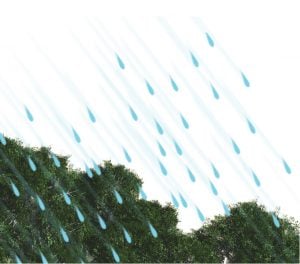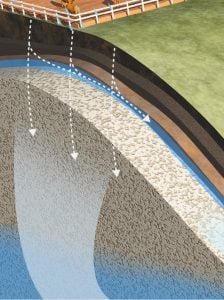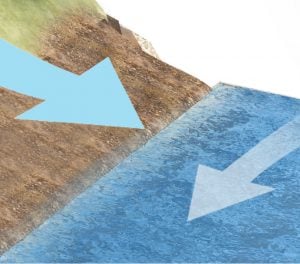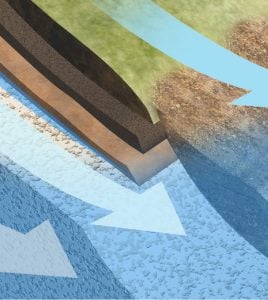Water in the Air

Scientists can determine when water first fell as rain by taking samples from the ground or streams and measuring the levels of chemicals it absorbed while still in the atmosphere. Those levels change from year to year. Chlorofluorocarbon aerosol levels were rising until 1996, when they were banned because they were eroding the Earth’s protective ozone layer. After that, the levels began to fall. Water tested today with levels of CFCs near their peak can be dated to 20 years ago, when levels began dropping. Moisture in the air also absorbs sulfur hexafluoride, another highly stable gas, which is used in industrial processes. Nuclear weapons have left their own radioactive fingerprints on groundwater supplies. Levels of tritium, an isotope of hydrogen created by nuclear blasts, rose after the start of atmospheric testing in 1945 and have been falling since it was banned in 1963. Heavy stable isotopes like deuterium are slower-moving than its more common cousins and fluctuate in time and space. All these chemicals help give every storm a different signature.
Water in the Ground

The moment a drop of rain reaches the water table, it stops absorbing trace elements and gases. A molecule of groundwater, in Harman’s terms, is born. Generally, the more time water spends in the ground, the more it is cleansed of surface and atmospheric contaminants by filtering through sand and rock. But the length of time water remains in the ground depends, to a large extent, on the terrain’s hidden architecture. As an engineer, Harman works with field scientists on computer programs that can incorporate the age of water with other factors to help trace its movement through the soil.
One implication of his work is that, in many places, the water in streams has passed through a larger volume of groundwater than previously thought. He recently worked with researchers from the University of Wyoming, who deployed a network of ground microphones around a stream valley in Baltimore County’s Oregon Ridge Park. Taking a break from his programming efforts, Harman was enlisted to strike a piece of steel with a sledgehammer. The sound of these strikes echoed through the ground, producing a kind of ultrasound image of the underlying soils.
The team found something much different from what standard textbooks said should be there. Instead of the stream cutting its way down through rock, the researchers found that the stream was aligned along the top of a hard, unweathered rock that fell away beneath the soft porous rock beneath the hills on either side. They also found much deeper flow paths for the water, he says, that take it as deep or deeper than the stream beds themselves. “There are still lots of things we don’t know about how water flows through the landscape,” says Harman.
Water in a Stream
 After a rain, streams become swollen. But what percentage of the water that falls as rain is immediately carried away by the stream? And how much remains in the ground? The question is important, because runoff generally carries more contaminants than subsurface water. Runoff depends in part on the permeability and level of saturation of the surrounding landscape. “When the catchment is very wet, we tend to see more flow paths activated,” Harman says. “That means that more of the younger water in the landscape is going to end up in the stream.”
After a rain, streams become swollen. But what percentage of the water that falls as rain is immediately carried away by the stream? And how much remains in the ground? The question is important, because runoff generally carries more contaminants than subsurface water. Runoff depends in part on the permeability and level of saturation of the surrounding landscape. “When the catchment is very wet, we tend to see more flow paths activated,” Harman says. “That means that more of the younger water in the landscape is going to end up in the stream.”
Sometimes, 90 percent of the volume of water that is in the stream is water that fell in the most recent storm. Sometimes, just 30 percent. In the latter case, much of the water in the stream will be groundwater that was squeezed out of the terrain by pressure from the rainwater that just fell. In other words, young water displaced old water. In some instances, Harman says, only 5 percent of the water in a stream after a storm might have come from the storm itself.
Water and Climate Change
 Harman and other scientists studying the effects of climate change on water supplies focus on the “critical zone”—everything that extends from the top of the forest canopy to the lowest depth where rainwater percolates.
Harman and other scientists studying the effects of climate change on water supplies focus on the “critical zone”—everything that extends from the top of the forest canopy to the lowest depth where rainwater percolates.
The age of water matters, Harman says, because it can affect everything from erosion rates to the health of fisheries to the safety of drinking water supplies.
If a hotter world produces an overall wetter climate, as many expect, that will have profound effects on this zone. More rain in the summer, Harman says, could produce a faster turnover of water closer to the surface and the slower flushing of water deeper in the system.
Since younger water tends to carry more atmospheric and surface pollutants, water quality could degrade. “With wetter and wetter conditions, the landscape is a less efficient filter,” Harman says. Climate change is expected to bring wetter winters to this area. Where it causes drier winters, older water may be flushed out into the streams faster, lowering the water table.




